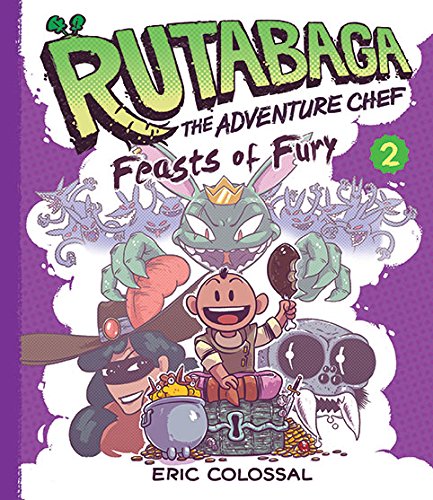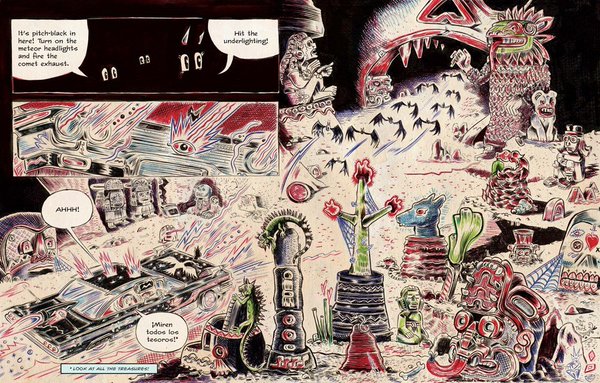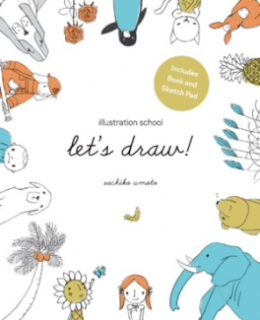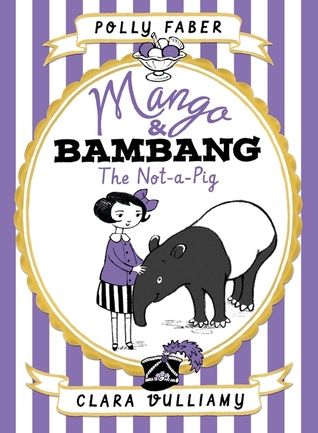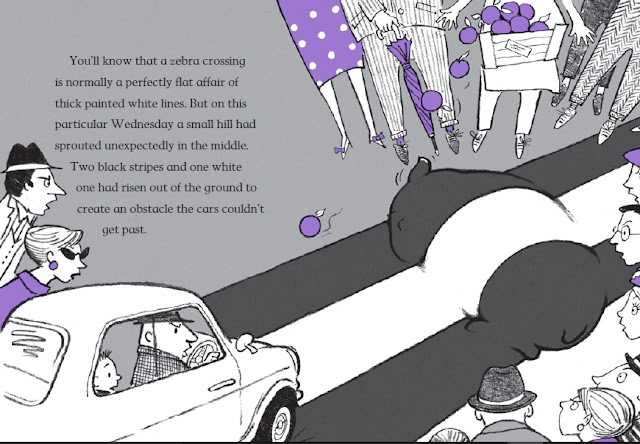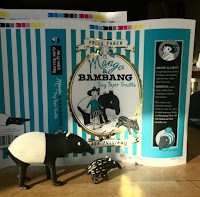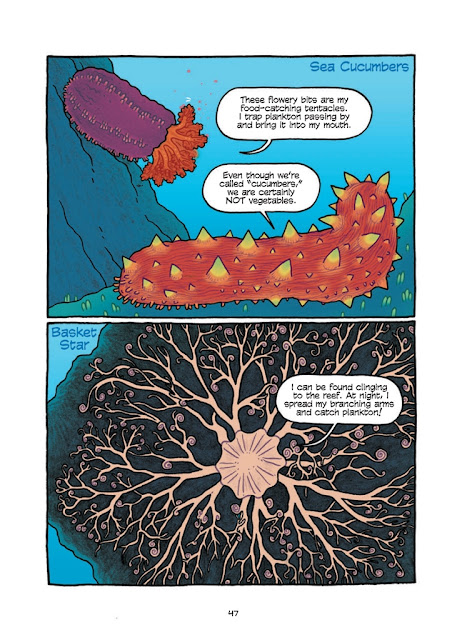Viewing: Blog Posts Tagged with: Reading Level 3, Most Recent at Top [Help]
Results 1 - 25 of 88
Blog: Children's Book Reviews and Then Some (Login to Add to MyJacketFlap)
JacketFlap tags: Reading Level 3, aauthor: Duddle, Pirates, Mystery, Series, Add a tag
Blog: Children's Book Reviews and Then Some (Login to Add to MyJacketFlap)
JacketFlap tags: Series, Cookbook, Reading Level 3, aauthor: Pépin, Add a tag
 As the daughter of Jacques Pépin, one of the first celebrity chefs on American television, Claudine Pépin has lived a life that makes her the perfect person to write a bilingual family cookbook featuring French cuisine. As she writes in her introduction, she "didn't grow up knowing how to cook," but she was around "tremendously good food." As a child, she spent summers in France with her grandmother, but instead of wearing a beret and riding a bicycle with a baguette under her arm, she was out in the country, peeling potatoes and eating a special goat cheese that was pungent enough that, when she would sweat, she "stank like goat cheese." Claudine cooked with her father on his show, as well as on other people's food shows. Along with her father, mother and twelve-year-old daughter, Pépin's husband, a professional chef and instructor at Johnson & Wales College of Culinary Arts, helped put together Let's Cook French: A Family Cookbook. As someone who loves cooking (and eating), especially when I know it is being enjoyed by my loved ones, I appreciate the traditions that three generations of a family have to share in this cookbook. I also love what Claudine said about her daughter in an interview with the Washington Post,
As the daughter of Jacques Pépin, one of the first celebrity chefs on American television, Claudine Pépin has lived a life that makes her the perfect person to write a bilingual family cookbook featuring French cuisine. As she writes in her introduction, she "didn't grow up knowing how to cook," but she was around "tremendously good food." As a child, she spent summers in France with her grandmother, but instead of wearing a beret and riding a bicycle with a baguette under her arm, she was out in the country, peeling potatoes and eating a special goat cheese that was pungent enough that, when she would sweat, she "stank like goat cheese." Claudine cooked with her father on his show, as well as on other people's food shows. Along with her father, mother and twelve-year-old daughter, Pépin's husband, a professional chef and instructor at Johnson & Wales College of Culinary Arts, helped put together Let's Cook French: A Family Cookbook. As someone who loves cooking (and eating), especially when I know it is being enjoyed by my loved ones, I appreciate the traditions that three generations of a family have to share in this cookbook. I also love what Claudine said about her daughter in an interview with the Washington Post, Pépin divides the book into four parts with headings that I love: To Start, To Continue, On the Side and To Finish. There are well known dishes you might expect, like Vichyssoise, Boeuf Bourguignon, Salade Niçoise, Crème Brûlée, Quiche, and Claudine's special Croque Monsieur, and, of course, Crêpes. There are also traditional recipes that I've heard of but never eaten and plan to make like Gougères, which are cheese puffs with suggestions on how to serve (warm and in a bread basket lined with a cloth napkin, naturellement) and Sablés, a French version of the sugar cookie.
Pépin divides the book into four parts with headings that I love: To Start, To Continue, On the Side and To Finish. There are well known dishes you might expect, like Vichyssoise, Boeuf Bourguignon, Salade Niçoise, Crème Brûlée, Quiche, and Claudine's special Croque Monsieur, and, of course, Crêpes. There are also traditional recipes that I've heard of but never eaten and plan to make like Gougères, which are cheese puffs with suggestions on how to serve (warm and in a bread basket lined with a cloth napkin, naturellement) and Sablés, a French version of the sugar cookie.  To get a better idea of the layout and complexity of the recipes in Let's Cook French, you can sample the Whole Roasted Chicken with Herbs of Provence, a classic Sunday dinner in France. As someone who likes to cook, these recipes and ingredients are not intimidating. Although the font is small, the instructions are always contained on one page. Honestly, while I adore the idea of a family cookbook, especially a bilingual one, I really think that this would be a fantastic cookbook to give to an adult chef who is comfortable in the kitchen and interested in exploring French cuisine for the first time. At least, that's how I plan to use this book!
To get a better idea of the layout and complexity of the recipes in Let's Cook French, you can sample the Whole Roasted Chicken with Herbs of Provence, a classic Sunday dinner in France. As someone who likes to cook, these recipes and ingredients are not intimidating. Although the font is small, the instructions are always contained on one page. Honestly, while I adore the idea of a family cookbook, especially a bilingual one, I really think that this would be a fantastic cookbook to give to an adult chef who is comfortable in the kitchen and interested in exploring French cuisine for the first time. At least, that's how I plan to use this book!Blog: Children's Book Reviews and Then Some (Login to Add to MyJacketFlap)
JacketFlap tags: Series, Cookbook, Reading Level 3, aauthor: Llamas, Add a tag
 Let's Cook Spanish: A Family Cookbook by Gabriella Llamas is one of three books in a new series from Quarry Books. And, while Llamas's book has all the qualities that I love in this series, from format, trim size and layout to the range and accessibility of the recipes, which appear in English and Spanish, it has something I especially like that Llamas has written an introduction for adults and for children. Llamas reminds parents that, "cooking with children is a communication based in trust, love and respect," that supports, "creativity, independence, responsibility, order, motivation, concentration, patience and courage." In her introduction for children, Llamas details the joys of sharing food with others, talking about the small bites developed by the Spanish as a way of sharing food. From tapas to pinchos (skewered bites) and raciones (a bigger portion to be shared among a few) which are all a Spanish way of eating as they "encourage human relations and friendships." She ends her introduction by reminding readers of two stand out habits that her parents taught her when she was young:
Let's Cook Spanish: A Family Cookbook by Gabriella Llamas is one of three books in a new series from Quarry Books. And, while Llamas's book has all the qualities that I love in this series, from format, trim size and layout to the range and accessibility of the recipes, which appear in English and Spanish, it has something I especially like that Llamas has written an introduction for adults and for children. Llamas reminds parents that, "cooking with children is a communication based in trust, love and respect," that supports, "creativity, independence, responsibility, order, motivation, concentration, patience and courage." In her introduction for children, Llamas details the joys of sharing food with others, talking about the small bites developed by the Spanish as a way of sharing food. From tapas to pinchos (skewered bites) and raciones (a bigger portion to be shared among a few) which are all a Spanish way of eating as they "encourage human relations and friendships." She ends her introduction by reminding readers of two stand out habits that her parents taught her when she was young:Blog: Children's Book Reviews and Then Some (Login to Add to MyJacketFlap)
JacketFlap tags: Graphic Novel, Series, Cookbook, Books About Food, Reading Level 3, GNRL3, aauthor: Colossal, Add a tag
 Last year I read and loved, as I do any book that makes food and cooking a central plot thread, Rutabaga the Adventure Chef #1 by Eric Colossal. Rutabaga, his pop-up kitchen and Pot, his trusty cauldron/pet, are back for more food, fun and adventure in Rutabaga the Adventure Chef: Feasts of Fury. And, as before, Rutabaga is a little bit goofy, a little bit gullible and a very passionate about cooking and feeding his friends, and even his enemies, from time to time.
Last year I read and loved, as I do any book that makes food and cooking a central plot thread, Rutabaga the Adventure Chef #1 by Eric Colossal. Rutabaga, his pop-up kitchen and Pot, his trusty cauldron/pet, are back for more food, fun and adventure in Rutabaga the Adventure Chef: Feasts of Fury. And, as before, Rutabaga is a little bit goofy, a little bit gullible and a very passionate about cooking and feeding his friends, and even his enemies, from time to time.Blog: Children's Book Reviews and Then Some (Login to Add to MyJacketFlap)
JacketFlap tags: Graphic Novel, cryptids, Reading Level 3, GNRL3, aauthor: Camper, Add a tag
 In 2014 I reviewed the stand out graphic novel Lowriders in Space written by author, artist and librarian Cathy Camper and illustrated by Raúl the Third. I didn't think it was possible, but I love the follow up, Lowriders to the Center of the Earth, even more than the first book! While the ingenuity of the characters, the cars, and of course, space travel were big draws in the first book, the second book manages to pack in even more fantastic features that I know the students in my school will love. Camper ups the usage of Spanish vocabulary in Lowriders to the Center of the Earth, including a coyote who puns in Spanish, and weaves characters and themes from Atzec mythology and Mexican folklore into this fast paced, action packed graphic novel with even more of the intensely detailed, superb illustrations by Raúl the Third.
In 2014 I reviewed the stand out graphic novel Lowriders in Space written by author, artist and librarian Cathy Camper and illustrated by Raúl the Third. I didn't think it was possible, but I love the follow up, Lowriders to the Center of the Earth, even more than the first book! While the ingenuity of the characters, the cars, and of course, space travel were big draws in the first book, the second book manages to pack in even more fantastic features that I know the students in my school will love. Camper ups the usage of Spanish vocabulary in Lowriders to the Center of the Earth, including a coyote who puns in Spanish, and weaves characters and themes from Atzec mythology and Mexican folklore into this fast paced, action packed graphic novel with even more of the intensely detailed, superb illustrations by Raúl the Third.Blog: Children's Book Reviews and Then Some (Login to Add to MyJacketFlap)
JacketFlap tags: Series, Reading Level 3, Art and Craft, Book List - summer activity books, aauthor: Umoto, Add a tag
Blog: Children's Book Reviews and Then Some (Login to Add to MyJacketFlap)
JacketFlap tags: Reading Level 3, aauthor: Faber, Add a tag

Polly Faber makes her debut as a children's book author with the story of a girl and her tapir - or maybe the story of a tapir and her girl, Mango & Bambang: The Not-a-Pig. Illustrated by the marvelous Clara Vulliamy, who, with her mother, the venerable British children's book author Shirley Hughes, created the Digby O'Day series, this new series has a similarly charming format that is perfect for emerging readers ready to move on to chapter books. Digby O'Day: In the Fast Lane and Digby O'Day and the Great Diamond Robbery feature illustrations on every page, great characters with intriguing details, fantastic design and a great story. Vulliamy, who is a very creative person with a website worth checking out (Sunny Side Up) is also a fan of felted animals. She commissioned dolls of Digby, Charlie and Digby's beloved red convertible as well as a cute little tapir - Bambang - which I first saw on her website last year.
 My kids grew up going to one of the best zoos in the world. I have known what a tapir is for decades and was so excited to see that someone chose this curious looking animal to be a character in a book! But first, Mango and the rest of the cast, as seen below.
My kids grew up going to one of the best zoos in the world. I have known what a tapir is for decades and was so excited to see that someone chose this curious looking animal to be a character in a book! But first, Mango and the rest of the cast, as seen below.Blog: Children's Book Reviews and Then Some (Login to Add to MyJacketFlap)
JacketFlap tags: Graphic Novel, Nature, Dinosaurs, aauthor: Reed, GNRL3, aauthor: Wicks, aauthor: Flood, Science, Reading Level 3, Add a tag

Blog: Children's Book Reviews and Then Some (Login to Add to MyJacketFlap)
JacketFlap tags: Fantasy, Series, New in Hardcover, Reading Level 3, Literary Rodents, FantasyRL3, aauthor: Vernon, Add a tag
Ursula Vernon is the author of the excellent, comic hybrid Dragonbreath series (Book 11 comes out January, 2016!) and the superb stand alone novel, Castle Hangnail. Vernon is a triple threat when it comes to kid's books. She is a great illustrator who makes creepy cute on every page. She is an imaginative author, always adding to the fantasy genre. And, best of all, she is a very funny
Blog: Children's Book Reviews and Then Some (Login to Add to MyJacketFlap)
JacketFlap tags: Graphic Novel, Reading Level 3, Mythology and Folklore, GNRL3, TOON Graphic, aauthor: Pommaux, Add a tag
Yvan Pommaux, beloved, multiple award-winning author and illustrator in France, has a detailed research and illustration style that we were treated too on this side of the Atlantic when TOON Graphics published Theseus and the Minotaur last year. Pommaux's books are a very welcome addition to the shelves of graphic novels and Greek mythology. George O'Connor's graphic novel series The
Blog: Children's Book Reviews and Then Some (Login to Add to MyJacketFlap)
JacketFlap tags: Books About Food, Reading Level 3, GNRL3, aauthor: Colossal, Graphic Novel, Series, Cookbook, Add a tag
Rutabaga the Adventure Chef by Eric Colossal began life as an online and is now available in book form and in full color (although I couldn't find any color images to share here...)! I absolutely love the character of Rutabaga and the world that Colossal has created for him to wander in. When we first meet him, he is trekking through the wilds with a huge pack on his back (it turns out to
Blog: Children's Book Reviews and Then Some (Login to Add to MyJacketFlap)
JacketFlap tags: New in Hardcover, Reading Level 3, Mythology and Folklore, GNRL3, TOON Graphic, aauthor: Pommaux, Add a tag
Theseus and the Minotaur is a new book by beloved French author Yvan Pommaux, known for his detailed research and illustration style, who has won many prestigious awards and had three schools named after him! Theseus and the Minotaur is also a new title from TOON Graphics, a new line of graphic novels for kids reading at 3rd grade level and above created by the amazing François Mouly and
Blog: Children's Book Reviews and Then Some (Login to Add to MyJacketFlap)
JacketFlap tags: Graphic Novel, Series, Reading Level 3, aauthor: Kibuishi, aauthor: Anthology, Good Fantasy - Harmless Bad Guys, FantasyRL3, GNRL3, Add a tag
The Explorer series, edited by Kazu Kibuishi, just keeps getting better. Mystery boxes then lost islands provided the themes of the graphic shorts in he first two books. Now, with hidden doors setting the theme for the third book in the series, imaginations soar even higher, if possible. As always, Kibuishi kicks off the book with a short of his own. "Asteria Crane" will remind you of his
Blog: Children's Book Reviews and Then Some (Login to Add to MyJacketFlap)
JacketFlap tags: aauthor: Camper, Graphic Novel, Reading Level 3, Cars and Trucks, GNRL3, Add a tag
Lowriders is Space is the first installment in what I hope will be a long graphic novel series written by Cathy Camper, author, artist and librarian and illustrated by Raúl the Third. Like no graphic novel I have seen before and arriving with a raft of celebrity blurbs from the likes of Jon Scieszcka, Megan McDonald and Amy Sedaris, Lowriders is Space is about three talented friends and
Blog: Children's Book Reviews and Then Some (Login to Add to MyJacketFlap)
JacketFlap tags: Halloween, Series, New in Hardcover, Reading Level 3, FantasyRL3, aauthor: Murphy, Add a tag
Originally published in 1974, author Jill Murphy, who was fifteen when she began writing The Worst Witch. The Worst Witch series is beloved in the UK and has been made into a television film and a television series that spawned two spinoff shows. Long before there was Hogwarts, there was Miss Cackle's Academy for Witches where out hero, Mildred Hubble, is a stand out student - a stand out
Blog: Children's Book Reviews and Then Some (Login to Add to MyJacketFlap)
JacketFlap tags: Reading Level 3, Notebook Novel, FantasyRL3, BRL3, GNRL3, Series, Graphic Novel, aauthor: Brown, Add a tag
Star Wars Reads Day (in schools) IS TODAY!!! Look for nationwide events in libraries & bookstores tomorrow also . . . Click here for more details By now, many of you may of a certain age and state of parenthood should have received or given a copy of Jeffrey Brown's books Darth Vader and Son and/or Vader's Little Princess on Father's Day, Christmas or another gift giving
Blog: Children's Book Reviews and Then Some (Login to Add to MyJacketFlap)
JacketFlap tags: Reading Level 3, Animals as Characters, FantasyRL3, aauthor: Bond, Classics, Add a tag
With the new live action movie coming out at the end of this year, there is a renewed interest in Paddington, the wayward bear from Darkest Peru. The Paddington Treasury, a collection of six picture book stories about Paddington and the Browns, the family that finds him at Paddington Station in London and takes him in, is a new, lovely collection with illustrations by American R.W. Alley,
Blog: Children's Book Reviews and Then Some (Login to Add to MyJacketFlap)
JacketFlap tags: Science, Series, New in Hardcover, Reading Level 3, aauthor: Scieszka, FantasyRL3, Add a tag
Frank Einstein and the Antimatter Motor by Jon Scieszka with fantastic illustrations by Brian Biggs is the book I have been most anticipating this year and it definitely delivers! Of course, everyone knows Scieszka, the author of contemporary picture book classics like The True Story of the Three Little Pigs and The Stinky Cheese Man and Other Fairly Stupid Fairy Tales, but The Time Warp
Blog: Children's Book Reviews and Then Some (Login to Add to MyJacketFlap)
JacketFlap tags: Reading Level 3, Sea Voyage, aauthor: McIntyre, New in Hardcover, aauthor: Reeve, FantasyRL3, Add a tag
I have been getting glimpses of Oliver and the Seawigs, by Philip Reeve and Sarah McIntyre since March of 2013 when they were at the Bologna Children's Book Fair promoting this fantastic book with and amazing array of seawigs, costumes and accoutrements. I've included a few images of the great getups that Reeve and McIntyre don for events, but be sure to check out Sarah's blog entries for
Blog: Children's Book Reviews and Then Some (Login to Add to MyJacketFlap)
JacketFlap tags: Fantasy, Series, Reading Level 3, Summer Stories, FantasyRL3, aauthor: Selfors, Add a tag
Along with Adam Gidwitz's phenomenal trilogy that begins with A Tale Dark and Grimm, Suzanne Selfors's Imaginary Veterinary series are very special in my house because they are the first full-fledged novels that my son read on his own, with great enthusiasm AND voraciousness, proving that he has the stamina and drive to move into a new realm of reading. I read and reviewed A Tale Dark and
Blog: Children's Book Reviews and Then Some (Login to Add to MyJacketFlap)
JacketFlap tags: Series, New in Hardcover, Real Life Boy Stories, Real Life Girl Stories, Reading Level 3, aauthor: McDonald, Add a tag
It's been so long since I read (and reviewed) a Judy Moody or Stink book (6 years!) that I forgot how much I love both of these characters - especially when their series cross paths. Double rare! Megan McDonald and Peter H. Reynolds have created truly memorable characters in these siblings. On top of that, way back in 2005, five years after the debut of the first Judy Moody, McDonald was
Blog: Children's Book Reviews and Then Some (Login to Add to MyJacketFlap)
JacketFlap tags: Mystery, New in Hardcover, Reading Level 3, aauthor: Angleberger, Add a tag
Of course any book with the word "poop" in the title is going to catch my attention - and that of most young readers. But the fact that a book with the word "poop" in the title is authored by the fantastic Tom Angleberger makes it a MUST READ. Originally published in 2007 by Dial Books as The Qwikpick Adventure Society by Sam Riddleburger and now out of print, Abrams Amulet has republished
Blog: Children's Book Reviews and Then Some (Login to Add to MyJacketFlap)
JacketFlap tags: aauthor: Bolton, Graphic Novel, Superheroes, Reading Level 3, Add a tag
SMASH: Trial by Fire, a graphic novel by Chris and Kyle Bolton reads like the handful of superhero middle grade novels that have been published over the last few years, which makes it perfect for an audience reading at a slightly lower level. Jack D Ferraiolo's Sidekicks is fast paced and suspenseful with a great plot twist as well as a poignant look at what it means to
Blog: Children's Book Reviews and Then Some (Login to Add to MyJacketFlap)
JacketFlap tags: Superheroes, New in Hardcover, Reading Level 3, Art and Craft, aauthor: King, Add a tag
Bart King is the undisputed master when it comes to writing fact-filled books for kids that are incredibly fun to read - and do. With The Big Book of Superheroes, illustrated by Greg Paprocki, King covers new territory, exploring the ins and outs of this semi-secret occupation. The Big Book of Superheroes is perfect for any kid with a great sense of imagination and drama, but it is also great
Blog: Children's Book Reviews and Then Some (Login to Add to MyJacketFlap)
JacketFlap tags: Reading Level 3, Summer Stories, aauthor: Hahn, SSRL3, Ghost Story, Add a tag
The Doll in the Garden: A Ghost Story by Mary Downing Hahn is a great book for a young reader who is looking for a good ghost story but needs a gentle start. The ghosts in this story are not malevolent, although there is a very cranky, mean old lady who hates cats. Approximately the same reading level as a Goosebumps book, Hahn's story offers a genuine ghost story without the
View Next 25 Posts


















